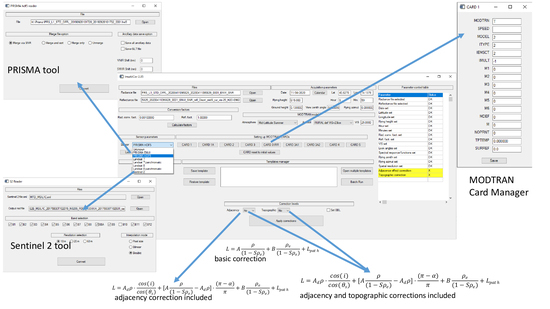ImaACor: A Physically Based Tool for Combined Atmospheric and Topographic Corrections of Remote Sensing Images
Abstract
:1. Introduction
2. Models
2.1. Atmospheric Model
2.2. MODTRAN Simulation
2.3. Environmental Function
2.4. Digital Elevation Model
3. ImaACor GUI
- “File”: manages the input and output of files.
- “Acquisition parameters”: manages the image acquisition parameters.
- “Conversion factors”: allows the setting of conversion factors.
- “MODTRAN Models”: manages the setting of atmospheric models for MODTRAN simulations.
- “Sensor parameters”: manages the setting of the instrumental parameters.
- “Setting up MODTRAN cards”: manages the MODTRAN card parameters.
- “DEM Processing”: manages the processing of the DEM for topographic correction.
- “Rrs processing”: allows the computation of remote sensing reflectance for water bodies.
- “Template manager”: manages templates (also for multiple runs in batch mode).
- “Correction levels”: allows one to set the corrections to be performed and start the correction process.
- “Parameter control table”: shows the set parameters.
3.1. File
3.2. Acquisition Parameters
- Date (dd/mm/yyyy).
- Latitude (decimal format).
- Longitude (decimal format).
- Flying height (km).
- Hour (hh).
- Minutes (mm).
- Ground height (km).
- Flying zenith (degree).
- Flying azimuth (degree).
3.3. Conversion Factors
3.4. MODTRAN Models
3.5. Sensor Parameters
3.6. Settings up the MODTRAN Cards
3.7. DEM Processing
3.8. Rrs Processing
3.9. Template Manager
3.10. Correction Levels
3.11. Control Table
4. ImaACor Application Results
5. Conclusions
6. Software Distribution
Author Contributions
Funding
Conflicts of Interest
References
- Guanter, L.; Del Carmen González-Sanpedro, M.; Moreno, J. A method for the atmospheric correction of ENVISAT/MERIS data over land targets. Int. J. Remote Sens. 2007, 28, 709–728. [Google Scholar] [CrossRef]
- Acito, N.; Diani, M. Unsupervised Atmospheric Compensation of Airborne Hyperspectral Images in the VNIR Spectral Range. IEEE Trans. Geosci. Remote Sens. 2018, 56, 2083–2106. [Google Scholar] [CrossRef]
- Amato, U.; Cavalli, R.; Palombo, A.; Pignatti, S.; Santini, F. Experimental Approach to the Selection of the Components in the Minimum Noise Fraction. IEEE Trans. Geosci. Remote Sens. 2008, 47, 153–160. [Google Scholar] [CrossRef]
- Santini, F.; Palombo, A. Physically Based Approach for Combined Atmospheric and Topographic Corrections. Remote Sens. 2019, 11, 1218. [Google Scholar] [CrossRef] [Green Version]
- Santini, F.; Alberotanza, L.; Cavalli, R.M.; Pignatti, S. A two-step optimization procedure for assessing water constituent concentrations by hyperspectral remote sensing techniques: An application to the highly turbid Venice lagoon waters. Remote Sens. Environ. 2010, 114, 887–898. [Google Scholar] [CrossRef]
- Hantson, S.; Chuvieco, E. Evaluation of different topographic correction methods for Landsat imagery. Int. J. Appl. Earth Obs. Geoinf. 2011, 13, 691–700. [Google Scholar] [CrossRef]
- Kawishwar, P. Atmospheric Correction Models for Retrievals of Calibrated Spectral Profiles from Hyperion EO-1 Data. Master’s Thesis, International Institute for Geo-Information Science and Earth Observation, Enschede, The Netherlands, 2007. [Google Scholar]
- Shepherd, J.D.; Dymond, J. Correcting satellite imagery for the variance of reflectance and illumination with topography. Int. J. Remote Sens. 2003, 24, 3503–3514. [Google Scholar] [CrossRef]
- Richter, R. Correction of atmospheric and topographic effects for high spatial resolution satellite imagery. Int. J. Remote Sens. 1997, 18, 1099–1111. [Google Scholar] [CrossRef]
- Sandmeier, S.R.; Itten, K.I. A physically-based model to correct atmospheric and illumination effects in optical satellite data of rugged terrain. IEEE Trans. Geosci. Remote Sens. 1997, 35, 708–717. [Google Scholar] [CrossRef] [Green Version]
- Guanter, L.; Kaufmann, H.; Segl, K.; Foerster, S.; Rogass, C.; Chabrillat, S.; Kuester, T.; Hollstein, A.; Rossner, G.; Chlebek, C.; et al. The EnMAP Spaceborne Imaging Spectroscopy Mission for Earth Observation. Remote Sens. 2015, 7, 8830–8857. [Google Scholar] [CrossRef] [Green Version]
- Guanter, L.; Richter, R.; Kaufmann, H. On the application of the MODTRAN4 atmospheric radiative transfer code to optical remote sensing. Int. J. Remote Sens. 2009, 30, 1407–1424. [Google Scholar] [CrossRef]
- Kobayashi, S.; Sanga-Ngoie, K. The integrated radiometric correction of optical remote sensing imageries. Int. J. Remote Sens. 2008, 29, 5957–5985. [Google Scholar] [CrossRef]
- Richter, R.; Schläpfer, D. Geo-atmospheric processing of airborne imaging spectrometry data. Part 2: Atmospheric/topographic correction. Int. J. Remote Sens. 2002, 23, 2631–2649. [Google Scholar] [CrossRef]
- Richter, R. Correction of satellite imagery over mountainous terrain. Appl. Opt. 1998, 37, 4004–4015. [Google Scholar] [CrossRef] [PubMed]
- Berk, A.; Anderson, G.P.; Acharya, P.K.; Chetwynd, J.H.; Bernstein, L.S.; Shettle, E.P.; Matthew, M.W.; Adler-Golden, S.M. Modtran4 User’s Manual. 1 June 1999. Available online: ftp://ftp.pmodwrc.ch/pub/Vorlesung%20K+S/MOD4_user_guide.pdf (accessed on 17 April 2000).
- Vermote, E.F.; Tanre, D.; Deuze, J.L.; Herman, M.; Morcette, J.-J. Second Simulation of the Satellite Signal in the Solar Spectrum, 6S: An overview. IEEE Trans. Geosci. Remote Sens. 1997, 35, 675–686. [Google Scholar] [CrossRef] [Green Version]
- Reinersman, P.; Carder, K. Monte Carlo simulation of the atmospheric point-spread function with an application to correction for the adjacency effect. Appl. Opt. 1995, 34, 4453–4471. [Google Scholar] [CrossRef]
- Sanders, L.C.; Schott, J.R.; Raqueno, R. A VNIR/SWIR atmospheric correction algorithm for hyperspectral imagery with adjacency effect. Remote Sens. Environ. 2001, 78, 252–263. [Google Scholar] [CrossRef]
- Vermote, E.F.; Vermeulen, A. Atmospheric Correction Algorithm: Spectral Reflectances (MOD09), version 4.0; ATBD: Baltimore, MD, USA, 1999. [Google Scholar]

















| Adjacency | Topographic | Processing Time | |
|---|---|---|---|
| X | X | X | 2:30 h |
| X | X | - | 5:10 min |
| X | - | - | 2:20 min |
| - | - | - | 1:20 min |
© 2020 by the authors. Licensee MDPI, Basel, Switzerland. This article is an open access article distributed under the terms and conditions of the Creative Commons Attribution (CC BY) license (http://creativecommons.org/licenses/by/4.0/).
Share and Cite
Palombo, A.; Santini, F. ImaACor: A Physically Based Tool for Combined Atmospheric and Topographic Corrections of Remote Sensing Images. Remote Sens. 2020, 12, 2076. https://doi.org/10.3390/rs12132076
Palombo A, Santini F. ImaACor: A Physically Based Tool for Combined Atmospheric and Topographic Corrections of Remote Sensing Images. Remote Sensing. 2020; 12(13):2076. https://doi.org/10.3390/rs12132076
Chicago/Turabian StylePalombo, Angelo, and Federico Santini. 2020. "ImaACor: A Physically Based Tool for Combined Atmospheric and Topographic Corrections of Remote Sensing Images" Remote Sensing 12, no. 13: 2076. https://doi.org/10.3390/rs12132076






